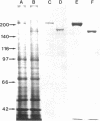Abstract
We used molecular genetic approaches to delete 521 amino acid residues from the proximal portion of the Dictyostelium myosin II tail. The deletion encompasses approximately 40% of the tail, including the S2-LMM junction, a region that in muscle myosin II has been proposed to be important for contraction. The functions of the mutant myosin II are indistinguishable from the wild-type myosin II in our in vitro assays. It binds to actin in a typical rigor configuration in the absence of ATP and it forms filaments in a normal salt-dependent manner. In an in vitro motility assay, both monomeric and filamentous forms of the mutant myosin II translocate actin filaments at 2.4 microns/s at 30 degrees C, similar to that of wild-type myosin II. The mutant myosin II is also functional in vivo. Cells expressing the mutant myosin II in place of the native myosin II perform myosin II-dependent activities such as cytokinesis and formation of fruiting bodies, albeit inefficiently. Growth of the mutant cells in suspension gives rise to many large multinucleated cells, demonstrating that cytokinesis often fails. The majority of the fruiting bodies are also morphologically abnormal. These results demonstrate that this region of the myosin II tail is not required for motile activities but its presence is necessary for optimum function in vivo.
Full text
PDF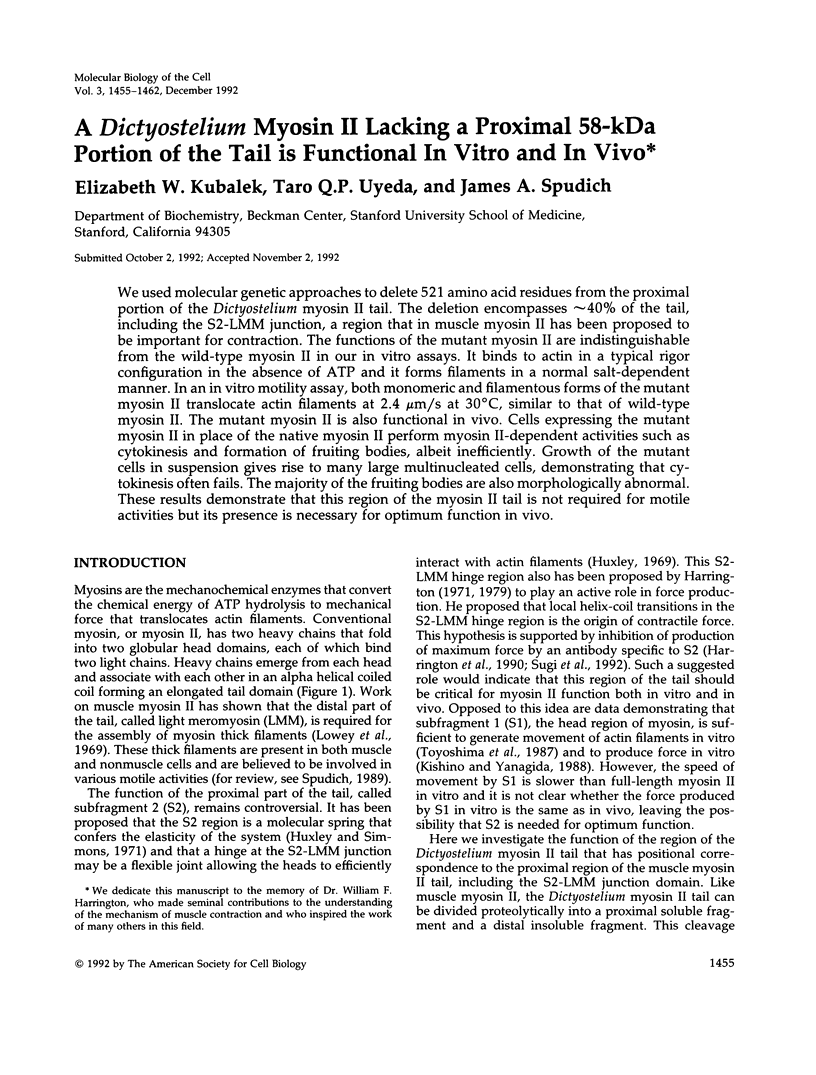
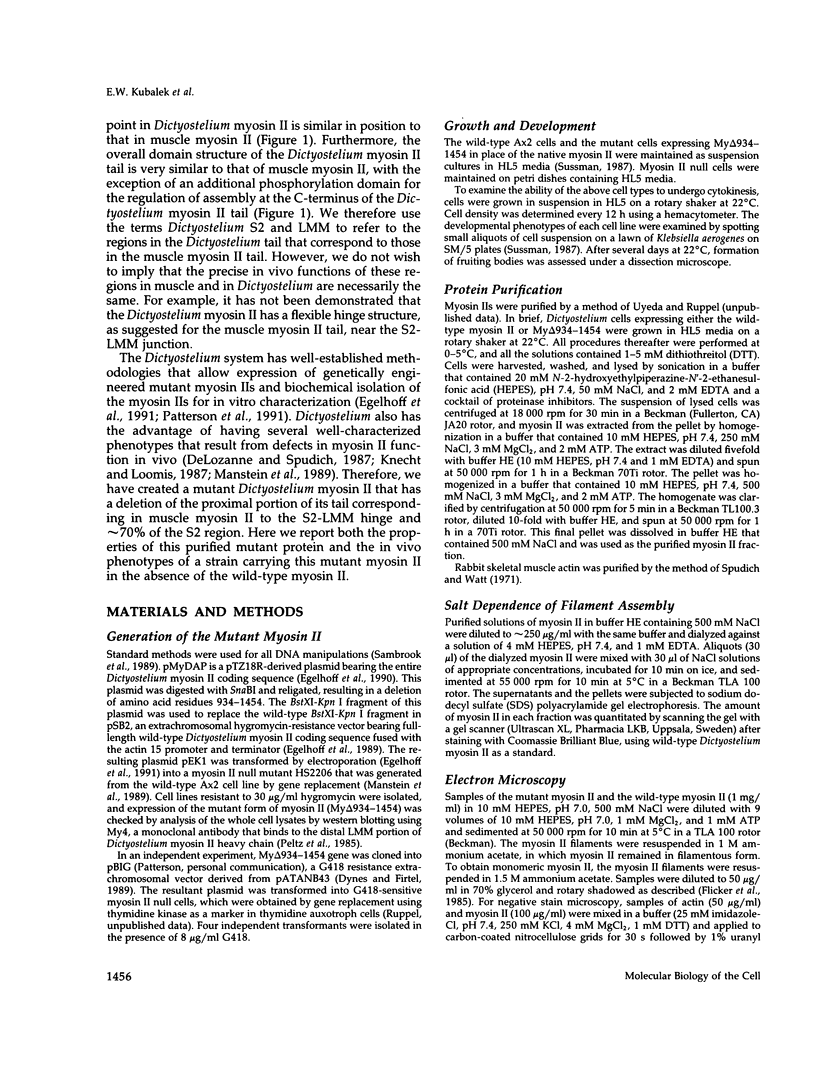
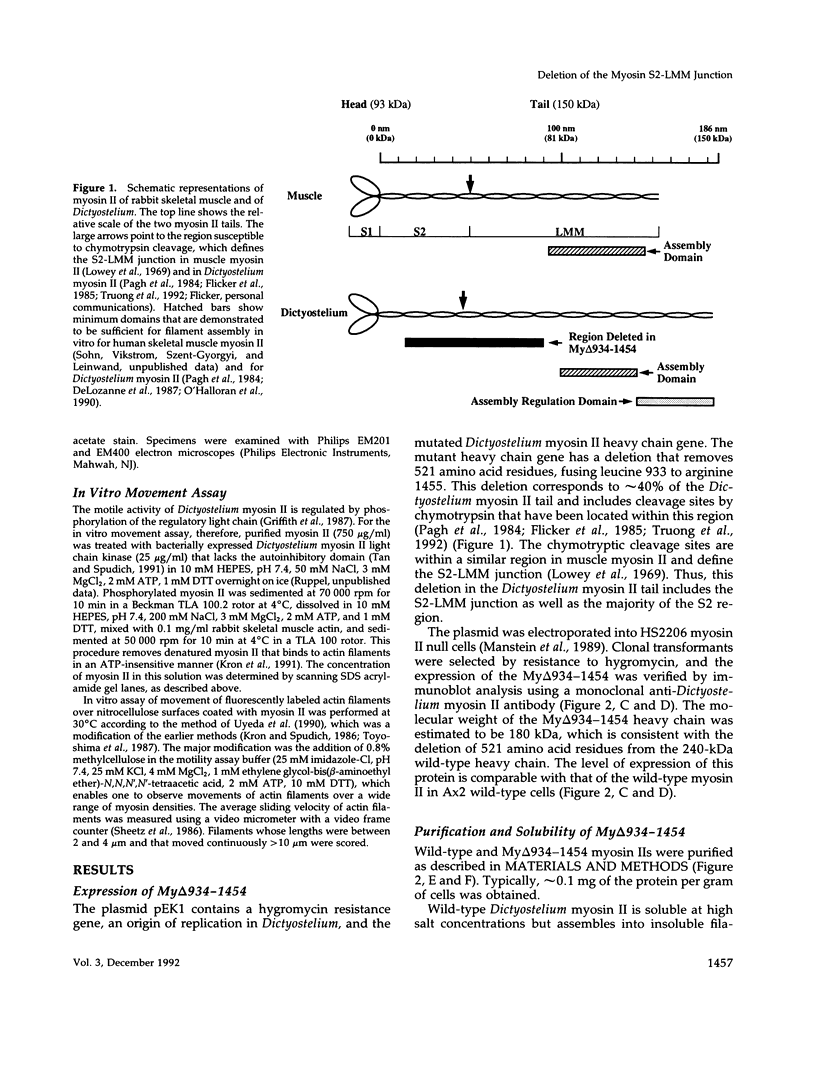
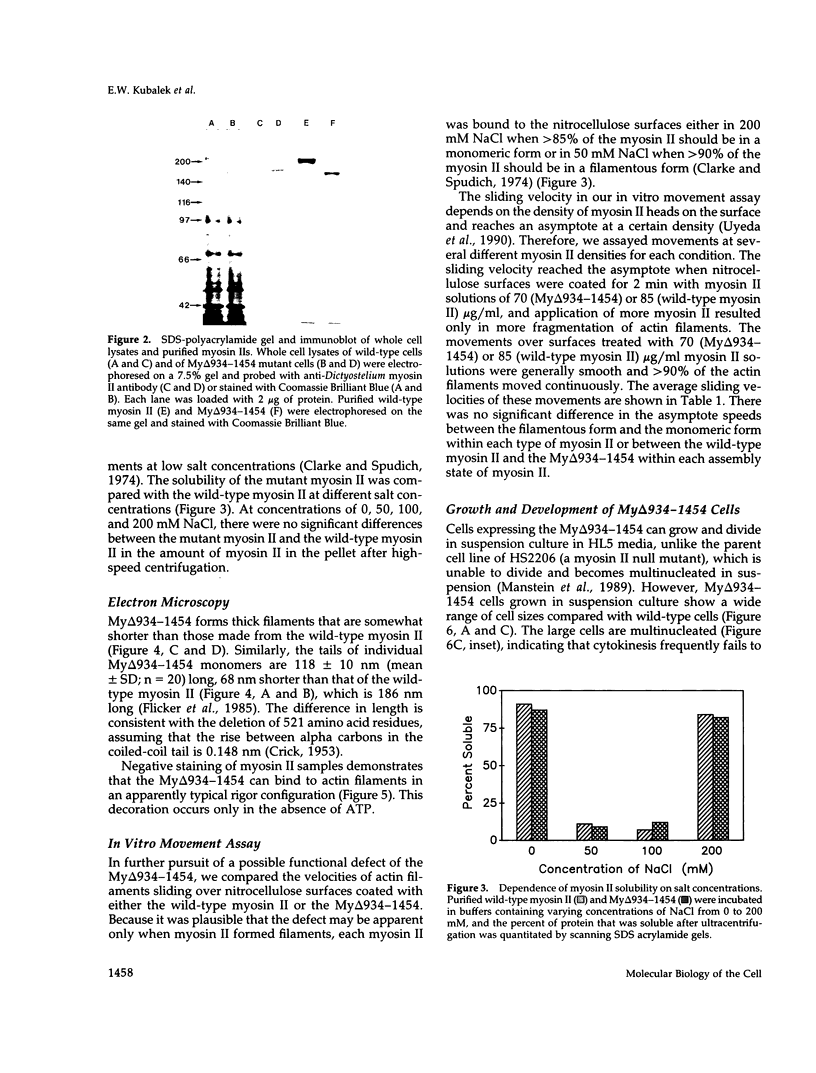
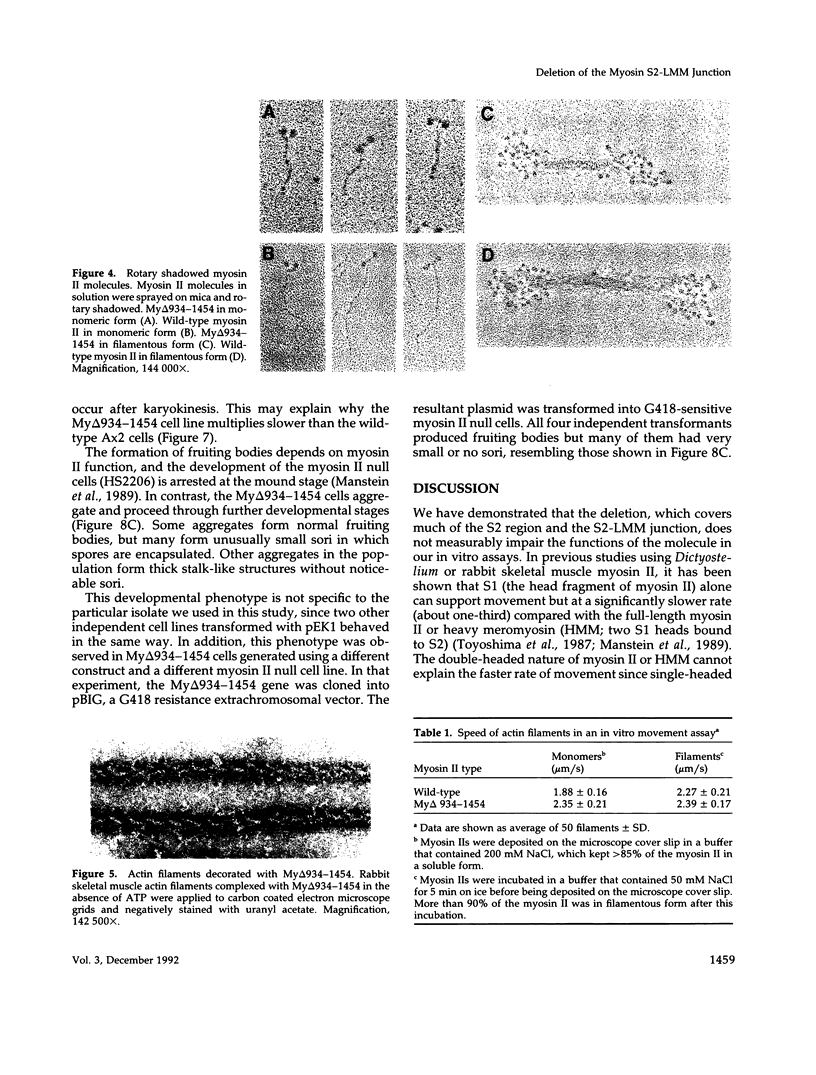
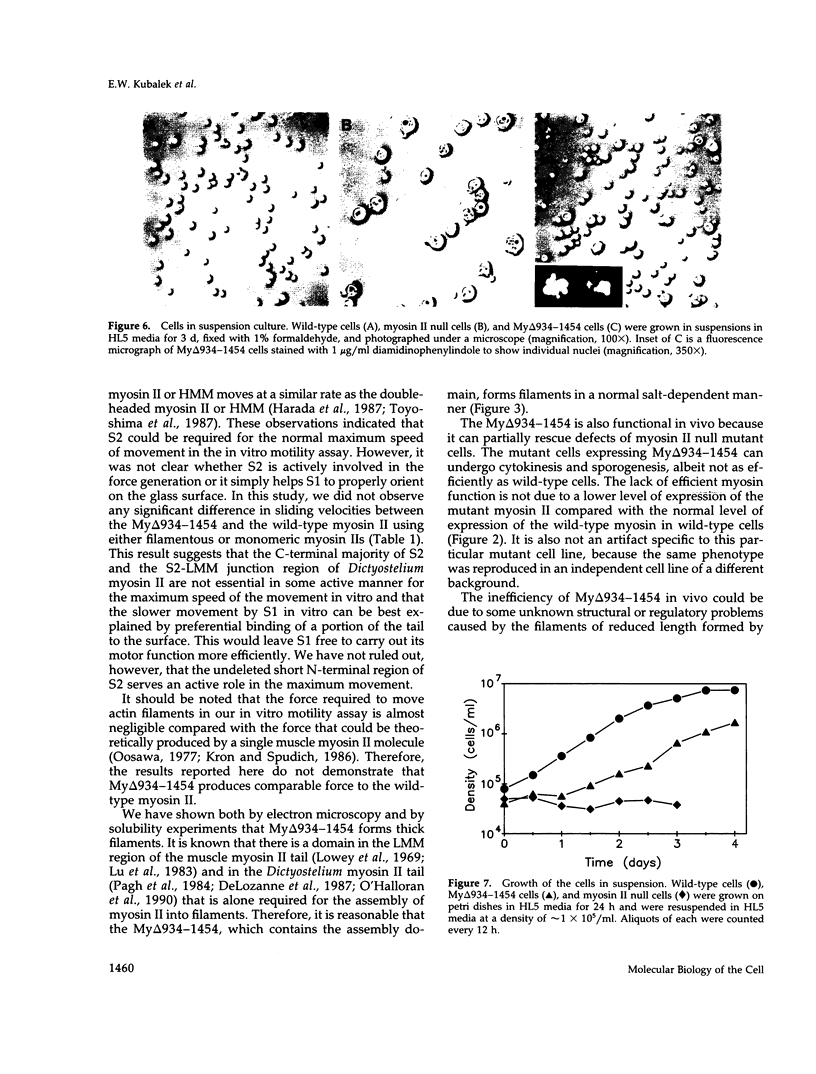
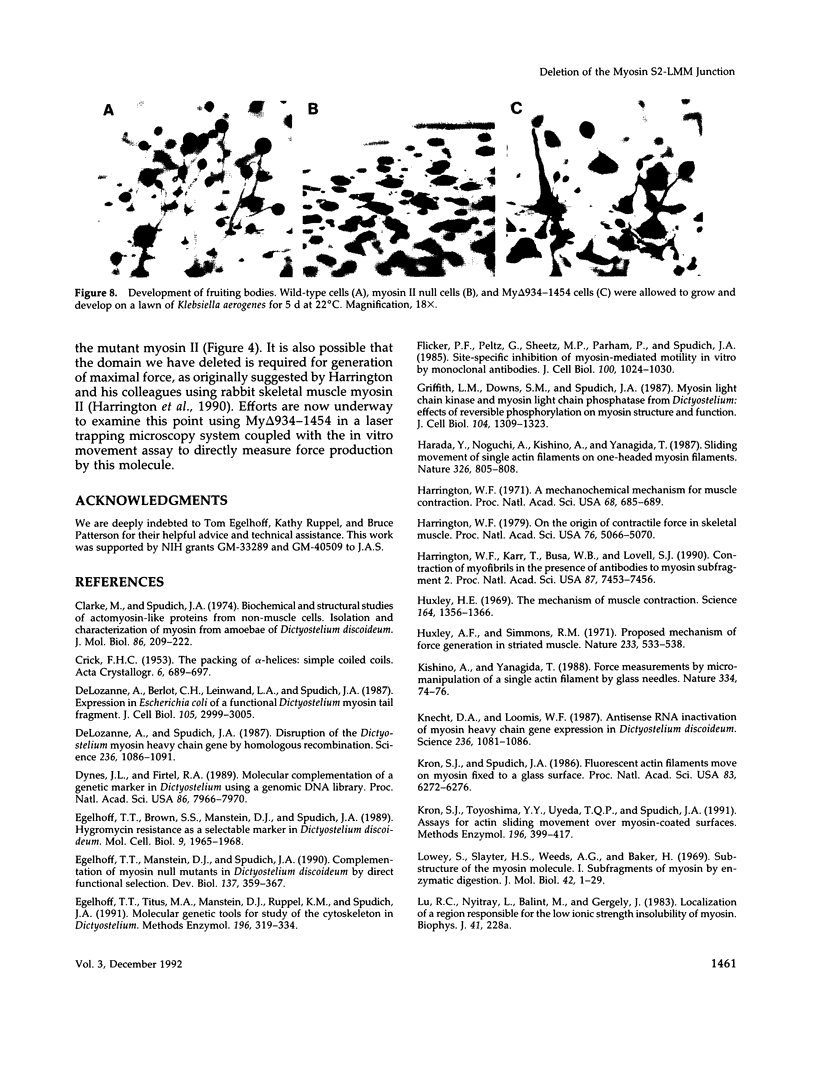
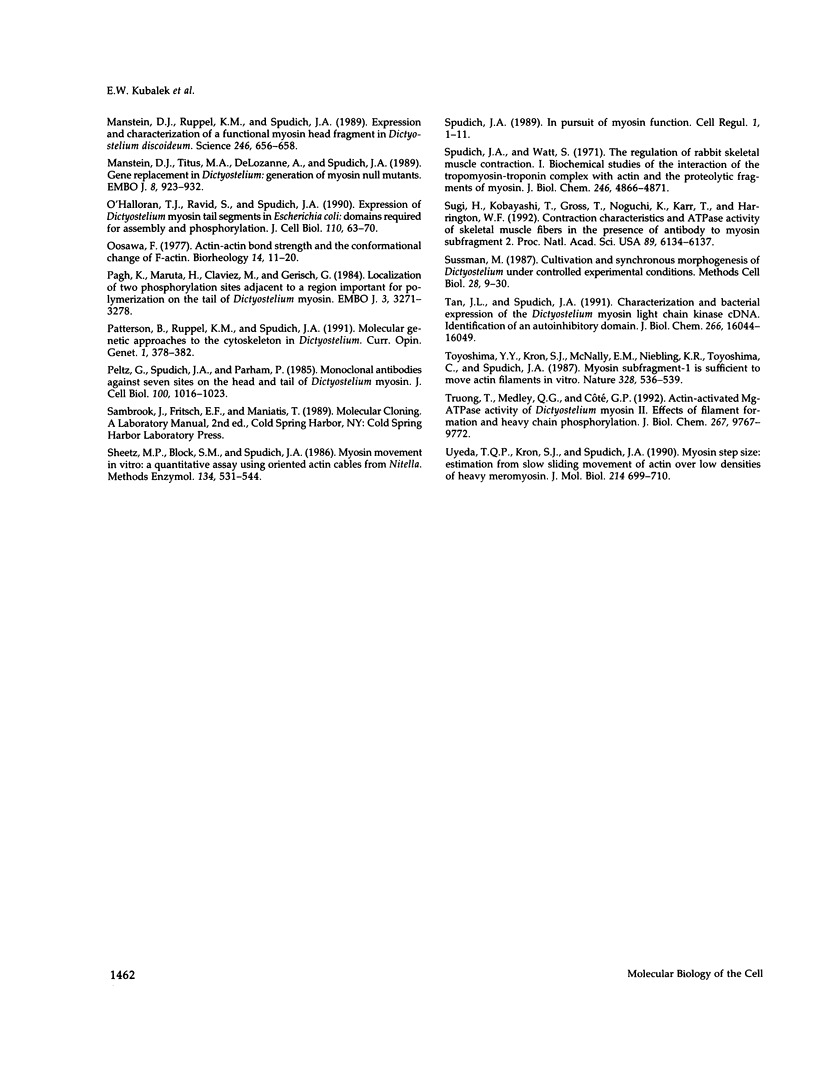
Images in this article
Selected References
These references are in PubMed. This may not be the complete list of references from this article.
- Clarke M., Spudich J. A. Biochemical and structural studies of actomyosin-like proteins from non-muscle cells. Isolation and characterization of myosin from amoebae of Dictyostelium discoideum. J Mol Biol. 1974 Jun 25;86(2):209–222. doi: 10.1016/0022-2836(74)90013-8. [DOI] [PubMed] [Google Scholar]
- De Lozanne A., Berlot C. H., Leinwand L. A., Spudich J. A. Expression in Escherichia coli of a functional Dictyostelium myosin tail fragment. J Cell Biol. 1987 Dec;105(6 Pt 2):2999–3005. doi: 10.1083/jcb.105.6.2999. [DOI] [PMC free article] [PubMed] [Google Scholar]
- De Lozanne A., Spudich J. A. Disruption of the Dictyostelium myosin heavy chain gene by homologous recombination. Science. 1987 May 29;236(4805):1086–1091. doi: 10.1126/science.3576222. [DOI] [PubMed] [Google Scholar]
- Dynes J. L., Firtel R. A. Molecular complementation of a genetic marker in Dictyostelium using a genomic DNA library. Proc Natl Acad Sci U S A. 1989 Oct;86(20):7966–7970. doi: 10.1073/pnas.86.20.7966. [DOI] [PMC free article] [PubMed] [Google Scholar]
- Egelhoff T. T., Brown S. S., Manstein D. J., Spudich J. A. Hygromycin resistance as a selectable marker in Dictyostelium discoideum. Mol Cell Biol. 1989 May;9(5):1965–1968. doi: 10.1128/mcb.9.5.1965. [DOI] [PMC free article] [PubMed] [Google Scholar]
- Egelhoff T. T., Manstein D. J., Spudich J. A. Complementation of myosin null mutants in Dictyostelium discoideum by direct functional selection. Dev Biol. 1990 Feb;137(2):359–367. doi: 10.1016/0012-1606(90)90260-p. [DOI] [PubMed] [Google Scholar]
- Egelhoff T. T., Titus M. A., Manstein D. J., Ruppel K. M., Spudich J. A. Molecular genetic tools for study of the cytoskeleton in Dictyostelium. Methods Enzymol. 1991;196:319–334. doi: 10.1016/0076-6879(91)96029-q. [DOI] [PubMed] [Google Scholar]
- Flicker P. F., Peltz G., Sheetz M. P., Parham P., Spudich J. A. Site-specific inhibition of myosin-mediated motility in vitro by monoclonal antibodies. J Cell Biol. 1985 Apr;100(4):1024–1030. doi: 10.1083/jcb.100.4.1024. [DOI] [PMC free article] [PubMed] [Google Scholar]
- Griffith L. M., Downs S. M., Spudich J. A. Myosin light chain kinase and myosin light chain phosphatase from Dictyostelium: effects of reversible phosphorylation on myosin structure and function. J Cell Biol. 1987 May;104(5):1309–1323. doi: 10.1083/jcb.104.5.1309. [DOI] [PMC free article] [PubMed] [Google Scholar]
- Harada Y., Noguchi A., Kishino A., Yanagida T. Sliding movement of single actin filaments on one-headed myosin filaments. Nature. 1987 Apr 23;326(6115):805–808. doi: 10.1038/326805a0. [DOI] [PubMed] [Google Scholar]
- Harrington W. F. A mechanochemical mechanism for muscle contraction. Proc Natl Acad Sci U S A. 1971 Mar;68(3):685–689. doi: 10.1073/pnas.68.3.685. [DOI] [PMC free article] [PubMed] [Google Scholar]
- Harrington W. F., Karr T., Busa W. B., Lovell S. J. Contraction of myofibrils in the presence of antibodies to myosin subfragment 2. Proc Natl Acad Sci U S A. 1990 Oct;87(19):7453–7456. doi: 10.1073/pnas.87.19.7453. [DOI] [PMC free article] [PubMed] [Google Scholar]
- Harrington W. F. On the origin of the contractile force in skeletal muscle. Proc Natl Acad Sci U S A. 1979 Oct;76(10):5066–5070. doi: 10.1073/pnas.76.10.5066. [DOI] [PMC free article] [PubMed] [Google Scholar]
- Huxley A. F., Simmons R. M. Proposed mechanism of force generation in striated muscle. Nature. 1971 Oct 22;233(5321):533–538. doi: 10.1038/233533a0. [DOI] [PubMed] [Google Scholar]
- Huxley H. E. The mechanism of muscular contraction. Science. 1969 Jun 20;164(3886):1356–1365. doi: 10.1126/science.164.3886.1356. [DOI] [PubMed] [Google Scholar]
- Kishino A., Yanagida T. Force measurements by micromanipulation of a single actin filament by glass needles. Nature. 1988 Jul 7;334(6177):74–76. doi: 10.1038/334074a0. [DOI] [PubMed] [Google Scholar]
- Knecht D. A., Loomis W. F. Antisense RNA inactivation of myosin heavy chain gene expression in Dictyostelium discoideum. Science. 1987 May 29;236(4805):1081–1086. doi: 10.1126/science.3576221. [DOI] [PubMed] [Google Scholar]
- Kron S. J., Spudich J. A. Fluorescent actin filaments move on myosin fixed to a glass surface. Proc Natl Acad Sci U S A. 1986 Sep;83(17):6272–6276. doi: 10.1073/pnas.83.17.6272. [DOI] [PMC free article] [PubMed] [Google Scholar]
- Kron S. J., Toyoshima Y. Y., Uyeda T. Q., Spudich J. A. Assays for actin sliding movement over myosin-coated surfaces. Methods Enzymol. 1991;196:399–416. doi: 10.1016/0076-6879(91)96035-p. [DOI] [PubMed] [Google Scholar]
- Lowey S., Slayter H. S., Weeds A. G., Baker H. Substructure of the myosin molecule. I. Subfragments of myosin by enzymic degradation. J Mol Biol. 1969 May 28;42(1):1–29. doi: 10.1016/0022-2836(69)90483-5. [DOI] [PubMed] [Google Scholar]
- Manstein D. J., Ruppel K. M., Spudich J. A. Expression and characterization of a functional myosin head fragment in Dictyostelium discoideum. Science. 1989 Nov 3;246(4930):656–658. doi: 10.1126/science.2530629. [DOI] [PubMed] [Google Scholar]
- Manstein D. J., Titus M. A., De Lozanne A., Spudich J. A. Gene replacement in Dictyostelium: generation of myosin null mutants. EMBO J. 1989 Mar;8(3):923–932. doi: 10.1002/j.1460-2075.1989.tb03453.x. [DOI] [PMC free article] [PubMed] [Google Scholar]
- O'Halloran T. J., Ravid S., Spudich J. A. Expression of Dictyostelium myosin tail segments in Escherichia coli: domains required for assembly and phosphorylation. J Cell Biol. 1990 Jan;110(1):63–70. doi: 10.1083/jcb.110.1.63. [DOI] [PMC free article] [PubMed] [Google Scholar]
- Oosawa F. Actin-actin bond strength and the conformational change of F-actin. Biorheology. 1977;14(1):11–19. doi: 10.3233/bir-1977-14102. [DOI] [PubMed] [Google Scholar]
- Pagh K., Maruta H., Claviez M., Gerisch G. Localization of two phosphorylation sites adjacent to a region important for polymerization on the tail of Dictyostelium myosin. EMBO J. 1984 Dec 20;3(13):3271–3278. doi: 10.1002/j.1460-2075.1984.tb02289.x. [DOI] [PMC free article] [PubMed] [Google Scholar]
- Patterson B., Ruppel K. M., Spudich J. A. Molecular genetic approaches to the cytoskeleton in Dictyostelium. Curr Opin Genet Dev. 1991 Oct;1(3):378–382. doi: 10.1016/s0959-437x(05)80303-x. [DOI] [PubMed] [Google Scholar]
- Peltz G., Spudich J. A., Parham P. Monoclonal antibodies against seven sites on the head and tail of Dictyostelium myosin. J Cell Biol. 1985 Apr;100(4):1016–1023. doi: 10.1083/jcb.100.4.1016. [DOI] [PMC free article] [PubMed] [Google Scholar]
- Sheetz M. P., Block S. M., Spudich J. A. Myosin movement in vitro: a quantitative assay using oriented actin cables from Nitella. Methods Enzymol. 1986;134:531–544. doi: 10.1016/0076-6879(86)34118-1. [DOI] [PubMed] [Google Scholar]
- Spudich J. A. In pursuit of myosin function. Cell Regul. 1989 Nov;1(1):1–11. doi: 10.1091/mbc.1.1.1. [DOI] [PMC free article] [PubMed] [Google Scholar]
- Spudich J. A., Watt S. The regulation of rabbit skeletal muscle contraction. I. Biochemical studies of the interaction of the tropomyosin-troponin complex with actin and the proteolytic fragments of myosin. J Biol Chem. 1971 Aug 10;246(15):4866–4871. [PubMed] [Google Scholar]
- Sugi H., Kobayashi T., Gross T., Noguchi K., Karr T., Harrington W. F. Contraction characteristics and ATPase activity of skeletal muscle fibers in the presence of antibody to myosin subfragment 2. Proc Natl Acad Sci U S A. 1992 Jul 1;89(13):6134–6137. doi: 10.1073/pnas.89.13.6134. [DOI] [PMC free article] [PubMed] [Google Scholar]
- Sussman M. Cultivation and synchronous morphogenesis of Dictyostelium under controlled experimental conditions. Methods Cell Biol. 1987;28:9–29. doi: 10.1016/s0091-679x(08)61635-0. [DOI] [PubMed] [Google Scholar]
- Tan J. L., Spudich J. A. Characterization and bacterial expression of the Dictyostelium myosin light chain kinase cDNA. Identification of an autoinhibitory domain. J Biol Chem. 1991 Aug 25;266(24):16044–16049. [PubMed] [Google Scholar]
- Toyoshima Y. Y., Kron S. J., McNally E. M., Niebling K. R., Toyoshima C., Spudich J. A. Myosin subfragment-1 is sufficient to move actin filaments in vitro. Nature. 1987 Aug 6;328(6130):536–539. doi: 10.1038/328536a0. [DOI] [PubMed] [Google Scholar]
- Truong T., Medley Q. G., Côté G. P. Actin-activated Mg-ATPase activity of Dictyostelium myosin II. Effects of filament formation and heavy chain phosphorylation. J Biol Chem. 1992 May 15;267(14):9767–9772. [PubMed] [Google Scholar]
- Uyeda T. Q., Kron S. J., Spudich J. A. Myosin step size. Estimation from slow sliding movement of actin over low densities of heavy meromyosin. J Mol Biol. 1990 Aug 5;214(3):699–710. doi: 10.1016/0022-2836(90)90287-V. [DOI] [PubMed] [Google Scholar]



